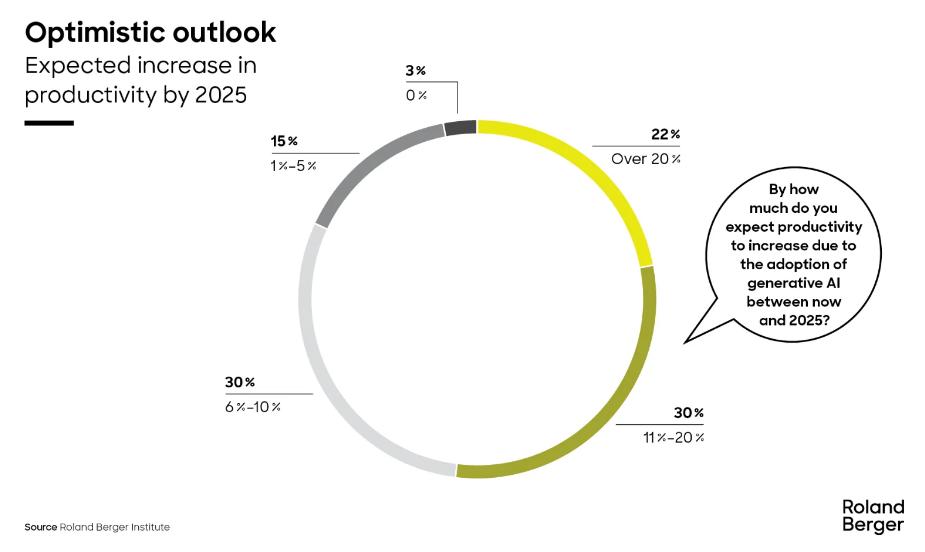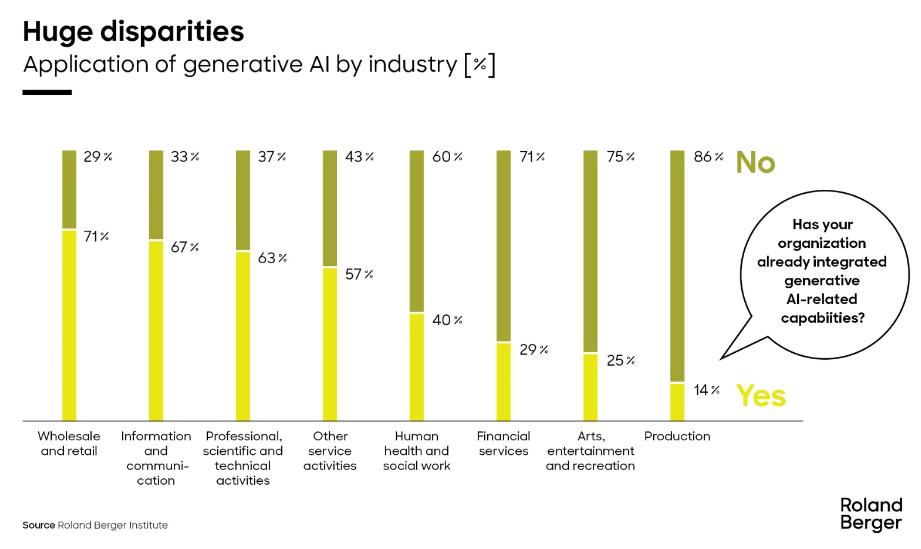AI Industry Report: ChatGPT Has Not Yet Triggered a Wave of Layoffs
-
At Roland Berger, we believe in the power of artificial intelligence to optimize outcomes. AI can enhance entire business models. Embracing new technologies and applying them strategically will enable enterprises to innovate faster, improve efficiency, foster collaboration, and make better decisions. To seize opportunities for value creation, enterprises must consider more than just adopting certain technologies. The successful application of AI requires businesses to undergo transformation across multiple dimensions and identify potential risks and uncertainties. Through thoughtful and prudent consideration, companies can leverage new technologies to optimize the deployment of existing assets.
Currently, expectations for generative AI are high. This technology is anticipated to do more than just address the productivity crisis in developed economies. A new study by Roland Berger suggests that generative AI can indeed help resolve the productivity crisis. When applied correctly, language models like ChatGPT can open up entirely new possibilities for boosting productivity—such as taking over routine back-office tasks or serving as digital assistants to help people tackle complex aspects of their work.
Interestingly, Roland Berger believes that the use of new AI language models will not, for the time being, lead to significant reductions in a company's workforce. Among the executives surveyed, only 16% plan to lay off 5% or more of their employees by the end of 2025. The majority of respondents expect no change in headcount. When it comes to anticipated productivity gains, the situation is quite the opposite: a vast majority (82%) believe it is realistic for businesses to achieve at least a 6% efficiency improvement from generative AI.
The current sentiment among corporate executives aligns with historical patterns observed during previous waves of innovation. History demonstrates that in the long run, major technological advancements create more new activities and businesses than the disruption they cause. This makes workforce reskilling and upskilling increasingly important for the future.

There are significant variations in how extensively companies adopt new tools and technologies in practice. While some industries are rapidly progressing, others remain very cautious in experimenting with generative AI.
According to Roland Berger's ranking, the leading industries adopting new technologies are wholesale and retail; information and communication; professional, scientific, and technical activities; and other service activities. In all these sectors, at least 57% of companies have deployed generative AI tools within their organizations. In contrast, only 14% of traditional manufacturing firms are currently exploring the potential of generative AI.
In different functional departments of companies within the same industry, we can observe similar disparities. While these new tools and technologies have already played a role in daily operations—such as marketing, communication, or customer service—their application in logistics or legal departments remains highly fragmented so far. Yet, identifying relevant use cases within the functionalities of these tools is not difficult. For instance, AI language models could take over legal precedent research, assist in drafting initial contract versions, or perform repetitive background checks.

It cannot be overlooked that generative AI will have a certain impact on work quality. Generative AI has the potential to increase employees' sense of identification with their work, thereby improving job satisfaction. This is likely to occur if these AI tools free up more time during the day for meaningful 'human' activities. For example, such activities might involve deepening client relationships or addressing strategic issues of critical importance.
Despite the current investment frenzy, a series of technical and practical obstacles still hinder the widespread adoption of generative AI. These issues include privacy concerns, such as the protection of trade secrets and personal data, or the tendency of current-generation language models to occasionally fabricate nonsensical answers (known as 'hallucinations'). Successfully embedding generative AI applications into corporate workflows also presents challenges, as many companies find it difficult to implement them effectively in practice. Only by overcoming these barriers can enterprises fully harness the potential of this new technology.
Analyzing the Impact of Artificial Intelligence
To develop a reliable AI strategy, companies first need to analyze their entire value chain to identify at which stages they can achieve efficiency improvements through generative AI. Roland Berger suggests that companies can use tools like the "Roland Berger AI Readiness Radar" for this purpose. Subsequently, companies should compare their findings with competitors' AI adoption levels and overall industry trends, while also analyzing their current IT infrastructure.
Developing Your Own AI Strategy
Once the preliminary research is completed, Roland Berger recommends that enterprises establish their overall objectives and productivity benchmarks. The next step should be planning the advancement of initial use cases. For enterprises, improving the management of all unstructured datasets becomes crucial here. All process data must be prepared in such a way that established models can be fine-tuned according to given business objectives. Alternatively, enterprises must be able to develop specialized models for highly specific tasks.
Concept Validation
Once all relevant technical details are determined—such as AI model selection, vendors, and integration plans—the enterprise's first use case can begin advancing. The subsequent focus will be on evaluation, including all iterative improvements, culminating in an enterprise-wide rollout plan. The primary goal for all companies should be ensuring the internal availability of their generative AI models, or even adapted existing models, across the entire organization.
